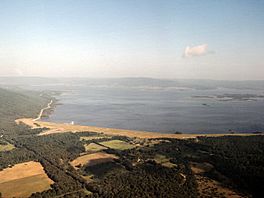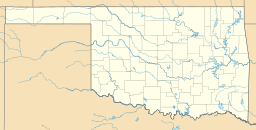Sardis Lake (Oklahoma) facts for kids
Quick facts for kids Sardis Lake |
|
|---|---|

Aerial view of Sardis Lake
|
|
| Location | Pushmataha / Latimer counties, Oklahoma, US |
| Coordinates | 34°39′30″N 95°22′44″W / 34.65833°N 95.37889°W |
| Type | reservoir |
| Primary inflows | Jackfork Creek |
| Primary outflows | Jackfork Creek |
| Basin countries | United States |
| Surface area | 14,360 acres (58 km2) |
| Average depth | 17 ft (5.2 m) |
| Water volume | 274,333 acre⋅ft (338.4 hm3) |
| Shore length1 | 117 mi (188 km) |
| Surface elevation | 599 ft (183 m) |
| Islands | None |
| Settlements | Clayton |
| 1 Shore length is not a well-defined measure. | |
Sardis Lake is a large, man-made lake, also known as a reservoir, located in Pushmataha and Latimer counties in Oklahoma, USA. It was created around 1980 when a dam was built across Jackfork Creek. This creek is a branch of the Kiamichi River. The lake gets its name from the old town of Sardis, Oklahoma, which had to be moved before the area was flooded to create the lake. Sardis Lake is about 5 miles (8.0 km) north of Clayton.
For many years, there were disagreements about who owned the water in Sardis Lake and how it could be used. This involved the state of Oklahoma and two Native American nations, the Chickasaw Nation and Choctaw Nation. They all wanted to make sure their water rights were protected. Eventually, in 2016, everyone involved reached an important agreement about the lake's water.
Contents
About Sardis Lake
Sardis Lake covers a huge area of about 14,360 acres (58 km2), which is like having over 14,000 football fields! It has a shoreline that stretches for 117 miles (188 km). The lake was formed by holding back the waters of Jackfork Creek, which then flows into the Kiamichi River.
The lake is surrounded by beautiful mountains. To the north and east, you'll find the Winding Stair Mountains. The Kiamichi Mountains are to the south, and the Jackfork Mountains are to the west. All these mountains are part of the larger Ouachita Mountains. Sardis Lake is about 45 miles (72 km) east of McAlester, Oklahoma. The water that flows into the lake comes from an area of about 275 square miles (710 km2).
Normally, the lake's water level is 599 feet (183 m) above sea level. At this level, it can hold about 274,330 acre-feet (338,380,000 m3) of water. When there's a lot of rain, the lake can rise to 607 feet (185 m) above sea level, and its capacity increases to 396,900 acre-feet (489,600,000 m3).
How Sardis Lake Was Built
The U.S. Army Corps of Engineers built the dam and the lake between 1977 and 1982. They did this under a special agreement with the state of Oklahoma. The main goal was to create a water supply that could be sold to cities and businesses in Oklahoma.
Oklahoma agreed to pay back the federal government for the construction costs over 50 years. The state also agreed to pay for running and maintaining the dam and lake. However, Oklahoma couldn't sell enough water to cover its costs, so it stopped making payments in 1997.
Because the state stopped paying, the federal government sued Oklahoma. The case went through several courts, and eventually, the federal government won. The Supreme Court decided not to hear Oklahoma's appeal. This meant that because Oklahoma didn't pay its debt, the Corps of Engineers legally owns Sardis Lake.
Plans for Moving Water
Soon after Sardis Lake was filled, Oklahoma City started looking for ways to get a lot of the lake's water for its own needs. They presented ideas to the Oklahoma Water Resources Board (OWRB) about how to move water from Sardis Lake closer to their city.
One early plan in 1992 suggested selling about 93 percent of the water to a water district in North Texas. Oklahoma City buys water from this district. Many people protested this idea, and the state legislature decided not to approve it.
A year later, there was another attempt to sell the lake's water to a different water district in Texas. This plan also suggested that the state legislature would put a seven-year pause on selling water outside of Oklahoma. But this plan also failed to pass.
Water Rights Lawsuits
In June 2010, the State of Oklahoma paid $27 million to the Corps of Engineers to settle its old debt for building the lake.
However, new disagreements arose. Oklahoma City wanted to buy a large amount of water from Sardis Lake. In 2011, a state contract set aside a huge amount of water (136,000 acre-feet) for the Oklahoma City Water Utilities Trust.
Native American Nations Take Action
The Chickasaw Nation and Choctaw Nation filed a lawsuit in federal court in 2011. They wanted to stop Oklahoma and Oklahoma City from moving water from Sardis Lake to Oklahoma City. They argued that they had not been included in the discussions, even though they had water rights in their traditional lands.
For example, the Choctaw Nation said that their 1830 Treaty of Dancing Rabbit Creek with the United States government gave them authority over water in their territory. They were also worried about having enough water for their people in the future.
In 2012, the State of Oklahoma filed its own lawsuit against the United States, which acts as a trustee for the Chickasaw and Choctaw Nations. Oklahoma argued that older treaties signed in the late 1800s, like those related to the Curtis Act and Dawes Act, meant the tribes no longer had these land and water claims.
Because of these lawsuits, all the groups involved started talking to each other to try and find a solution. Representatives from the U.S. Department of Justice and Department of Interior also joined these talks.
Experts believed that the outcome of this case could have a big impact. If the Chickasaw and Choctaw Nations won, it could help other Native American tribes protect their water rights. If Oklahoma won, it could make it harder for tribes to claim their water rights, which might affect their future.
The 2016 Water Agreement
In 2016, a very important agreement was reached by all the groups involved in the lawsuits: the state of Oklahoma, Oklahoma City, and the Chickasaw and Choctaw Nations. This agreement settled all the ongoing issues related to Sardis Lake's water.
This settlement was officially approved by federal law, called "Choctaw Nation of Oklahoma and the Chickasaw Nation Water Settlement, WINN Act, PL 114-322". It was also approved by laws passed by the State, the two Native American Nations, and Oklahoma City.
In short, the agreement states that Oklahoma will manage and control Sardis Lake. However, it also protects the water rights of the Chickasaw and Choctaw Nations in their treaty territories. A large part of the water from Sardis Lake will go to Oklahoma City, but only if the city takes steps to save water.



